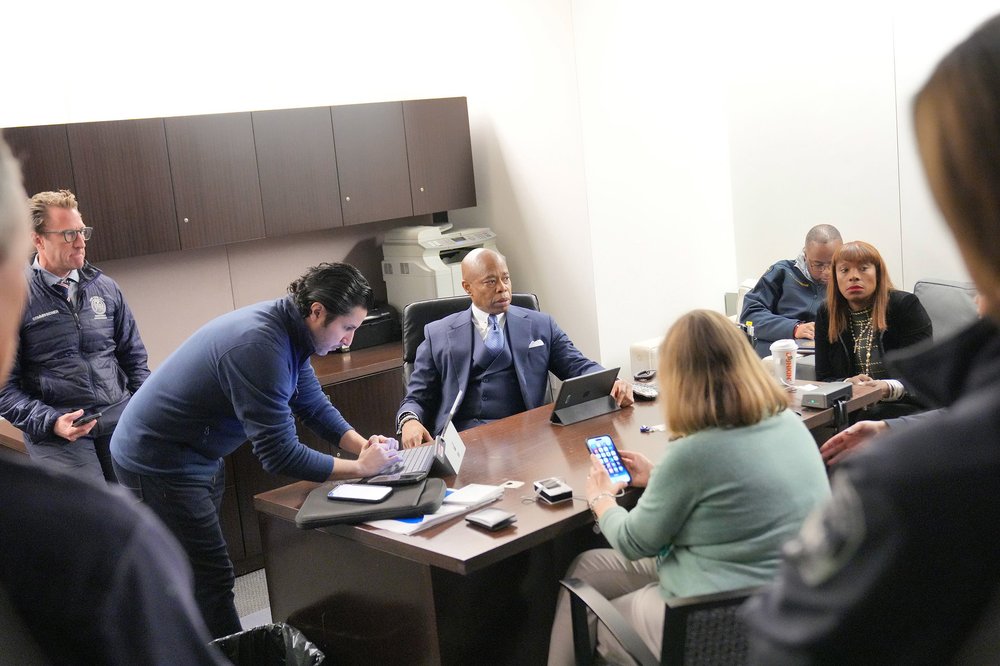NYC officials took more than 20 minutes to alert New Yorkers about earthquake
April 5, 2024, 5:38 p.m.
Emergency management officials said they needed to confirm the earthquake and compose guidance for the public.

New York City emergency management officials took 24 minutes to send out the first public alert about an earthquake that rumbled buildings throughout the city and left many New Yorkers confused about what exactly had happened.
The 4.8 magnitude earthquake began at 10:23 a.m, according to the U.S. Geological Survey. But the city’s first warning went out at 10:47 a.m. on Notify NYC, a system that was developed in 2007 and has more than 1 million subscribers. A broader alert to all cellphone users did not go out until 11:01 a.m. While the mayor called a press conference within two hours of the quake, the delayed notification marks yet another flub from the Adams administration during a natural disaster.
“Twenty minutes is very, very fast for a public notification,” Emergency Management Commissioner Zach Iscol told reporters when pressed about the lag at a press conference with Mayor Eric Adams.
But Mark Levine, the Manhattan borough president, expressed concern about the time it took for official alerts about the earthquake to be issued. In an email to constituents, Levine wrote that he and others did not receive the emergency cellphone text for over an hour after the earthquake happened.
“This is unacceptable,” he wrote. “New Yorkers deserve a system that provides them with critical information when they need it most. This earthquake didn't cause major damage, but if this delay had happened during a more severe incident, the consequences could have been significant.”
An aftershock measuring magnitude 3.8 was felt across the area around 6 p.m. Friday, USGS said. Notify NYC issued an alert about it at 6:12 p.m., advising residents to stay indoors and call 911 if injured. No aftershock alert was sent to all cell phone users.
Councilmember Justin Brannan of Brooklyn dryly responded to the morning's late alert on social media.
“Yes boo we know,” he wrote.
Yes boo we know pic.twitter.com/vGeP4oFzPS
— Justin Brannan (@JustinBrannan) April 5, 2024
Brannan later told Gothamist that he was joking and that he did not know what goes into sending such an alert.
“I would hope it goes through a serious approval process,” he wrote in a text message.
In California, where earthquakes are far more common and often more severe, residents receive an instant push notification on their phone for earthquakes that are magnitude 5.0 or higher. The warning system uses ground motion sensors that allow people to take cover even before shaking occurs.
There were no major reports of damage or injuries from Friday’s earthquake, which was centered about 50 miles west of New York City.
The mayor’s office noted that the state sent its first cellphone alert at 12:05 p.m. That's more than an hour and a half after the quake hit.
Jackie Bray, the commissioner for the state’s Division of Homeland Security and Emergency Services, said in an interview on WNYC on Friday afternoon that the criticism of the city was unfair.
“When you’re in an emergency operation center, you are checking to make sure that you are absolutely right,” she said. “Because you’re not just sending it to people who have signed up for alerts, you are sending it to every single cell phone.”
The Adams administration has not had the best track record with natural disasters.
The mayor took hours to appear before the public in September after severe weather flooded neighborhoods, closed major thoroughfares and forced the shutdown of much of the subway system. The city’s slow response to the driving rain was especially difficult for parents and schoolchildren, who trudged through some of the worst conditions to get to school on time.
Three months earlier, Adams was faulted for taking too long to address the public about the smoky air conditions caused by Canadian wildfires. A brown haze enveloped the city for a full day and evening and created breathing difficulties for many New Yorkers, but City Hall didn't publicly address the issue until 11:30 p.m.
Unlike those events, the mayor convened a press briefing less than two hours after the earthquake.
Notable quake, preliminary info: M 4.8 - 7 km N of Whitehouse Station, New Jersey https://t.co/DuTYZ1kb4X
— USGS Earthquakes (@USGS_Quakes) April 5, 2024
According to a city emergency management spokesperson, the city confirmed the earthquake at 10:34 a.m.
While earthquakes in the Northeast are rare compared to California, where seismic activity is closely monitored, Friday’s event suggested that the city is far from being the best equipped to warn New Yorkers if a serious earthquake occurs.
When it comes to receiving earthquake alerts, other sources exist. The National Earthquake Information Center operates a 24-hour service that detects and measures earthquakes.
"We're probably the quickest source of information," said Will Yeck, a research geophysicist with the National Earthquake Information Center. "You can get email alerts or text alerts from that, and that'd be the fastest way to get heads up information about the earthquake."
Charles Lane contributed reporting. This story has been updated with comments from Manhattan Borough President Mark Levine and New York Homeland Security Commissioner Jackie Bray.
Historic earthquake rattles NJ and NYC, briefly stalling stunned region Dozens evacuate damaged Newark row homes after earthquake hits NYC, NJ